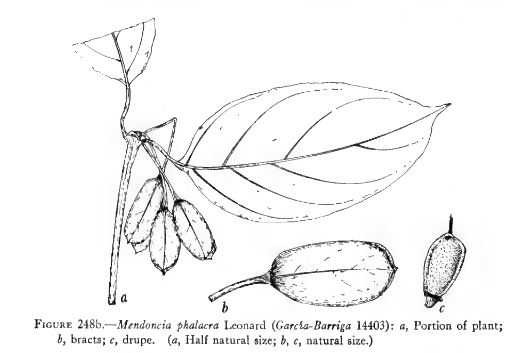
|
Family: Acanthaceae
|
Vine; stems shallowly grooved, subterete, glabrous, 3 mm. in diameter near the fruiting nodes; leaf blades oblong-elliptic, up to 12.5 cm. long and 7.5 cm. wide, short-acuminate and bluntly apiculate, entire, both surfaces glabrous, the costa and lateral veins (4 pairs) moderately prominent; petioles 1.5 to 2.5 cm. long, more or less sulcate, glabrous; flowers solitary or in pairs in the axils of the upper leaves; peduncles up to 4 cm. long, toward base terete and 1 mm. in diameter, gradually enlarged to 3 mm. at the subquadrangular tip, sulcate, glabrous; bracts oblong-elliptic, up to 3 cm. long and 1.5 cm. wide, rounded and mucronulate, the tip of the bract and the mucro more or less recurved, rounded at the base, green, glabrous, the costa faint; mature corollas not seen; drupe 17 mm, long, 1 cm. broad, 7 mm, thick, obtuse, flattened and oblique at tip, yellow, glabrous. Type in the U. S. National Herbarium, No. 2173522, collected at Jino-Gojé, between the Ríos Piraparaná and Popeyaká, in the Río Apaporis valley, Vaupés, Colombia, 250 meters altitude, September 3 to 11, 1952, by H. García-Barriga (No. 14403). Mendoncia phalacra is unique in being strictly glabrous and in the rounded, more or less recurved, mucronulate tips of the bracts, which are very noticeable. The species has no close relatives among those known to grow in Colombia. The specific epithet is from the Greek word paλakpós, meaning smooth or glabrous. |




